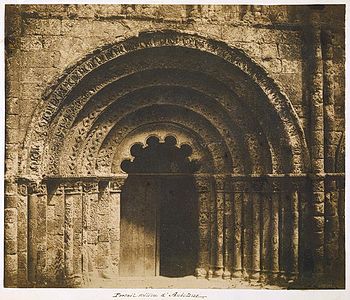- Missions Héliographiques
-
Prosper Mérimée established the Missions Héliographiques in 1851 to supplement Monument historique a program he had established in 1837 to classify, protect and restore French landmarks.[1] Mérimée, noted author of Carmen, served as France's Inspector General of Historical Monuments, and he hired Edouard Baldus, Hippolyte Bayard, Gustave Le Gray, Henri Le Secq and O. Mestral.[2] These five photographers photographed various landmarks and monuments around France so that the architect Eugène Viollet-le-Duc could eventually restore them.
Although the daguerrotype originated in France, Mérimée preferred the calotype, which offered more detailed textures.[3]
 Central Portal of the Church of Saint-Jacques, Aubeterre - Gustave Le Gray (1851)
Central Portal of the Church of Saint-Jacques, Aubeterre - Gustave Le Gray (1851)
While Mestral and Le Gray went southwest from Paris, Le Secq’s itinerary sent him north and east. Bayard, who burdened himself by choosing to work with glass negatives instead of paper, went west, to Brittany and Normandy. Finally, Baldus spent time in the south and east, where he photographed the Palace of Fontainebleau and other landmarks.[4]
While several of the photographs remain classic examples of early photography, the results were mediocre at best. Ironically, the photographers’ artistry helped doom the project: Exquisite photos of the decaying buildings portrayed them in a positive manner that did nothing to show the need for restoration.[2]
Notes
- ^ Rosenblum, Naomi. "Documentation: Landscape and Architecture." A World History of Photography. Ed. Walton Rawls and Nancy Grubb. 3rd ed. New York: Abbeville Press, 1997. 100.
- ^ a b Rosenblum, p. 100.
- ^ Fulton, Marianne. European Architecture. J 362E. Harry Ransom Center, University of Texas. 31 Jan. 2008.[vague]
- ^ Mission Héliographique, 1851 | Thematic Essay | Timeline of Art History | The Metropolitan Museum of Art
- ^ Lemagny, Jean-Claude etal. (1986). A History of Photography: Social and Cultural Perspectives. Cambridge: Cambridge University Press. pp. 55–56. ISBN 0 521 34407 7.
Categories:- Photography in France
- Photographic collections and books
- Architectural history
- Photography stubs
Wikimedia Foundation. 2010.
